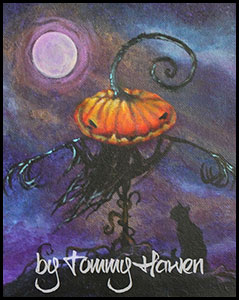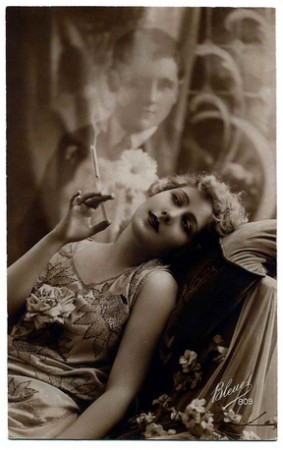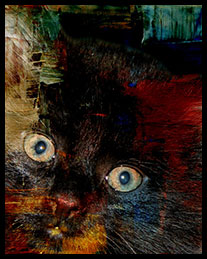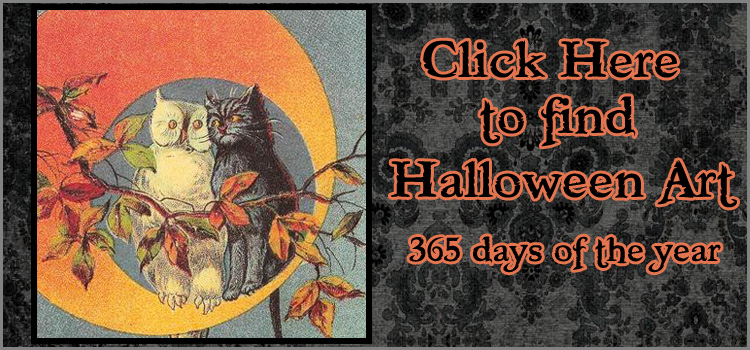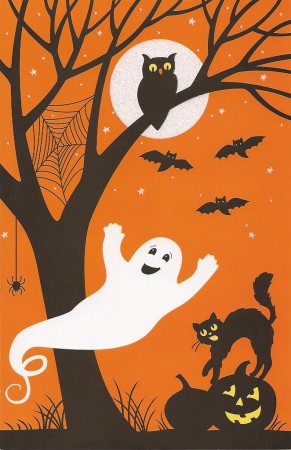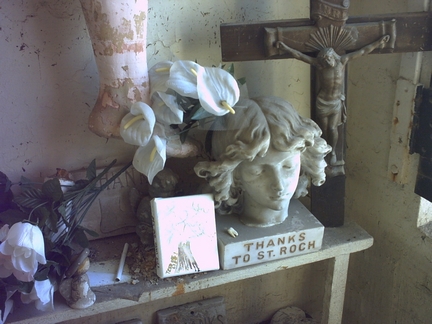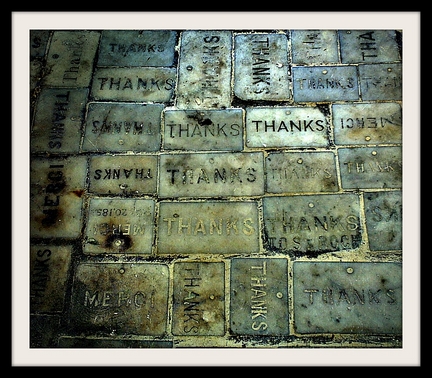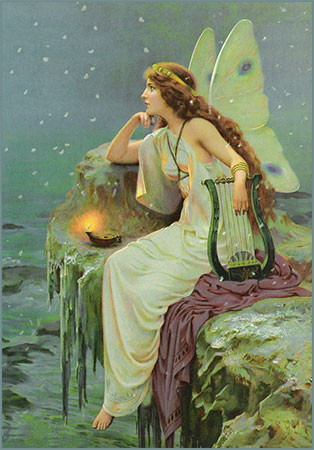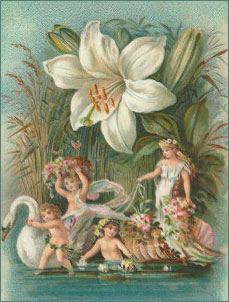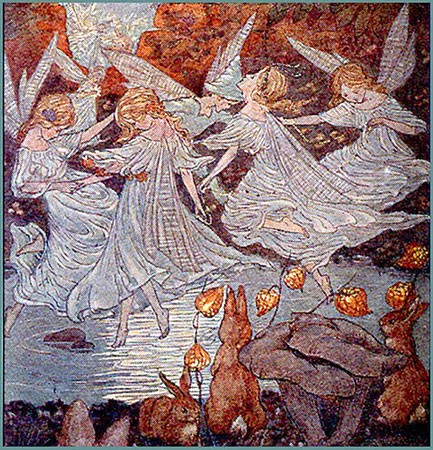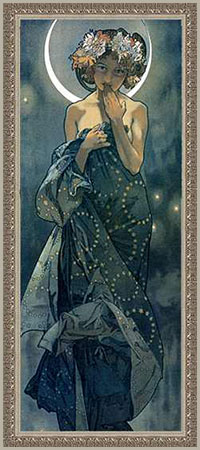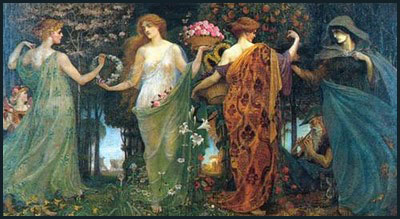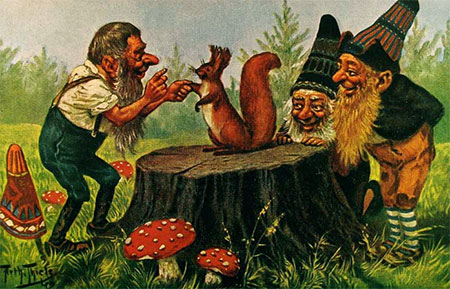
The Secret History of Gnomes.
-By Angelique Duncan
When one sees a statue of a garden gnome one would never realize the grand and noble history that they hold. Their beginnings are much loftier than the life they hold now, residing in the suburbs among the daises and St. Augustine.
The name Gnome quite literally means “Earth Dweller” and is synonymous with Pygmaei or as we know the term today, Pygmies. Once believed to stand 3-4 feet tall, masculine, strong in physique with long beards. Their possible history reaches back to the ancient Roman Greco era to a tribe in Greek mythology who were secondary deities who co existed with humans. The Gnomes were considered highly skilled in nature magic. Gnomes were seen as benevolent beings that were intelligent and wise, hard working in manual labor, peaceful in nature yet fierce defenders when necessary. They were the guardians of farmland; gardens and small livestock and forest animals. When lands were under attack they rode upon goat back brandishing spears to drive out the invaders.
In Roman mythology they were considered akin to the Roman fertility god Priapus protector of livestock fruit and gardens and considered very virile. It is believed that Gnomes are depicted consistently as male figures in history and rarely referenced as female in that the Gnomes were defenders of the meek and all things worthy of protection. It is believed they were very protective of their women and would defend them to all cost against predators and intruders, and later in history from humans.
In Celtic and Germanic lore, the Gnomes were a tribe attributed with Earth element magic and were defenders of mines and under ground tunnels. It was believed that gnomes could move through the Earth and breath underground with the same ease their human counterparts do above ground in the air. Some associate Gnomes as descendants of the Dwarves of Germanic and Norse legends for the ability to move underground and the belief that Gnomes were skilled miners. It was thought that they helped to build under ground tunnels to hide treasures and riches of the fae folk after the great invasions of ancient Ireland, and from humans in modern times.
The history and genealogy of the Gnomes is also believed to be traced to the Tomte or Nisse of Scandinavian folklore. The Tomote are sometimes believed to be an incarnation of a deceased ancestor of the home who comes back to defended the children and animals of the estate and would help with chores, particularly gardening and farm work. The Scandinavian folklore of the Tomote gave rise to the legend of and has associations with the winter elves who appear at Yule.
The size of the Gnomes is widely accepted as a physical attribute, although some historians and mythologist suggest that their representation of small size was more figurative than literal in that in their possible origins they came form lesser spirits or gods. The modern depiction of Gnomes in literature is significantly smaller than what is written in ancient mythology. The modern accepted stature of a Gnome is 2-3 feet tall and in many instances as short as 1 foot tall.
One theory between folklorist and mythologist is that Gnomes adapted to the world around them. That the Gnomes became smaller to better navigate an ever-increasing population of humans and development. Shape shifting to a smaller size helps to keep them hidden. Others believe that the gradual change of Gnomes appearance was the result of the Christian church marginalizing pagan deities through depictions of art and restructuring of legends to aid in making Christianity more palatable to Pagans. Many descriptions of Pagan deities through the Christian church had their attributes downplayed and magical properties lessened. Benevolent entities and magical creatures of Pagan nature religions were often diminished from noble in spirit to mischievous sometimes comical and in most instances considered dangerous as the Church weaned the populace from their previous beliefs to Christianity. By making these entities appear small made them seem less powerful than the Church and what it’s religious deities had to offer. Stories of Gnomes were homogenized more closely with legend of Dwarves and described as irritable, impatient, war like and ugly in appearance. The Gnomes as stoic guardians eventually faded into the stuff of myths.
The use of small statues of Gartenzwege or garden dwarf has remained tremendously popular through out Europe since the 1600’s. Folks would display a small porcelain statue of a Gnome in there home as a protector. Tying to the legends of the Tomte. It was common practice to keep either a wooden, terracotta or ceramic Gnome in ones garden to act as a guardian to discourage nighttime intruders invading ones crops. A popular folk tale in the 1970’s was that Gnome statues secretly came to life after dark working their gardens, shooing away pests. When the sun rose they returned to their post, turning back to stone.
The industry for lawn statues grew in time with demand for garden gnomes becoming hugely popular in pre Word War II Germany. Most were produced from hand sculpted molds, however declined post war to only a few original family manufacturers. They are now mass- produced all over the world using cheaper materials. The depiction has changed as well. Once the imagery was more sober and wise in appearance however after release of Disney’s ‘Snow White and the Seven Dwarves”, Gnome statues took on the more rounded chubby appearance and became seen as more comical nature. Gnomes have had many depictions in literature and often interchangeable to different small statured magical species, affecting their representation in art and statuary.
Till this day Gnomes enjoy popularity in culture. Garden Gnomes have become a central figure in games and pranks known as “gnoming”. One incarnation of “gnoming” is to steal a Gnome from it’s garden and place it randomly in another so that the Gnome travels the neighborhood, often appearing in unconventional places like on rooftops or inside mailboxes. Another popular fad is to send a gnome with a note attached to travel around the world to see how far it will go and if it will return back to it’s previous location. Some Gnomes become victims of theft that results in a ransom note listing bizarre demands.
Perhaps the existence of Gnome like creatures has existed in so many cultures and mythologies due to their ability to travel great distances undetected under ground. Maybe those cheery faced, pointy hat statues decorating the lawns of the sub-burbs still enjoy late night adventures. Is it possible the reason the petunias were spared from the grasshoppers as the result of the fierce protection of ones garden Gnome? Maybe. The only one who knows is the Gnome, and he is stone faced and isn’t speaking.

Angelique Duncan is proprietor of Twilight Faerie Nostalgic and Capricious Objects. Check out her artist page to find links to her shops and vintage inspired traditional holiday art. Visit again next month for more traditions and folklore.

